I was happily browsing through the wares in one of my favorite local thrift stores. This pleasant, inexpensive pastime has often led me to unexpected treasures. Most of my shirts, boots, books, small electronics, and a myriad of other useful items have originated as other people’s castoffs.
On this particular day, on a shelf piled high with tired-looking cordless phones, slightly battered clock radios, and orphaned wall warts, something caught my eye. It was a well-worn headlamp, a Pelican 2620 HeadsUP Lite. I already had a Coast HX4 that I was quite pleased with (SurvivalBlog published my review of it on April 8, 2020). But in spite of its scuffed exterior, the Pelican unit appealed to me. It appeared to be constructed of a heavy-gauge polymer material, it was priced at only 50 cents, and it was assembled in the USA. I thought it might be useful as a back-up, if nothing else. After all, “Two is one, and one is none.” So I put the headlamp into the cart that my wife was pushing, paid for it at the checkout, and gave it a new home on a shelf in my workshop.
The headlamp sat there, half-forgotten, throughout the long days of summer. Autumn brought shorter days. I found myself working outside before sunrise and after sunset more and more often. More time working in the dark reminded me of a major weakness of the Coast HX4: it is only rated for three and a half hours of continuous use. The batteries needed to be replaced on a fairly regular basis, occasionally at inopportune times. Finally one day I decided to give the Pelican 2620 a closer look. I was surprised to find that it is rated for up to 80 hours of continuous use. I was certain that this was a typo, but decided to give it a try.
Initial Impressions
 The 2620 is held in place by a head band rather than a visor clip like the HX4. It is heavier than the HX4, but since the band holds it closer to the head, the perceived weight is actually about the same. The 2620 is highly water resistant. At least one user reports that it can be used under water, although I have my doubts. The beefy switch, which is easy to manipulate even with gloves on, clicks authoritatively between three settings: Off, LED, and Xenon.
The 2620 is held in place by a head band rather than a visor clip like the HX4. It is heavier than the HX4, but since the band holds it closer to the head, the perceived weight is actually about the same. The 2620 is highly water resistant. At least one user reports that it can be used under water, although I have my doubts. The beefy switch, which is easy to manipulate even with gloves on, clicks authoritatively between three settings: Off, LED, and Xenon.
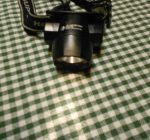 The LED setting is more like a spot and less like a flood than the HX4, although it can be adjusted to some degree by twisting the lens assembly. The end result is that the 2620 is not quite as pleasant as the HX4 for close work, but is better for spotting things a little farther away. The Xenon setting is not very practical in my opinion. It produces significantly less light than the LED setting, while exhausting the battery significantly more quickly. The 2620 lacks the red setting of the HX4, which is useful for preserving night vision. This feature of the HX4 allows the user to utilize ambient light to detect more distant objects while more clearly revealing obstacles in the immediate vicinity.
The LED setting is more like a spot and less like a flood than the HX4, although it can be adjusted to some degree by twisting the lens assembly. The end result is that the 2620 is not quite as pleasant as the HX4 for close work, but is better for spotting things a little farther away. The Xenon setting is not very practical in my opinion. It produces significantly less light than the LED setting, while exhausting the battery significantly more quickly. The 2620 lacks the red setting of the HX4, which is useful for preserving night vision. This feature of the HX4 allows the user to utilize ambient light to detect more distant objects while more clearly revealing obstacles in the immediate vicinity.
The 2620 comes with two headbands. The cloth headband can be used to fasten the lamp directly to the users’ head or over cloth headwear like stocking caps or baseball caps. It works much better with my boonie hat than the clip on the HX4. The rubber headband can be used to fasten the lamp to smooth headgear like hard hats.
Replacing the Xenon Bulb with a Red LED
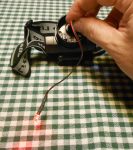 After deciding that the Xenon bulb was not particularly useful, I began to wonder if I could replace it with a red LED bulb. To find out, I removed the front lens assembly, the reflector, and the Xenon bulb. I had a 12 volt white LED that I knew functioned at lower voltages. I inserted the wires from that LED into the holes for the pins of the Xenon bulb. The LED lighted nicely.
After deciding that the Xenon bulb was not particularly useful, I began to wonder if I could replace it with a red LED bulb. To find out, I removed the front lens assembly, the reflector, and the Xenon bulb. I had a 12 volt white LED that I knew functioned at lower voltages. I inserted the wires from that LED into the holes for the pins of the Xenon bulb. The LED lighted nicely.
The 2620 is powered by three AAA batteries, so I calculated that it would produce about 4.5 volts. I then ordered a package of 4.5 volt red LED bulbs from Amazon. Six days later, the red LEDs arrived.
I took one of the LEDs, cut its wires to the same length as the pins in the Xenon bulb, stripped off the insulation, and inserted them into the holes for the Xenon bulb pins. I had a 50/50 chance of getting the polarity right on my first try. My first attempt did not succeed, but the LED lighted up nicely on my second try. After inserting the bulb, I replaced the reflector and the front lens assembly. The LED stuck out farther than the Xenon bulb, so replacing the front lens assembly pushed it to one side.
 The goal for the red LED was to produce enough light to read a map, to see objects immediately in front of my feet while walking, and to accomplish this without ruining my night vision. Since the bulb was pushed to one side by the front lens cover, the light did not project very well. It gave enough light to read a map, but not enough to see objects at my feet while walking.
The goal for the red LED was to produce enough light to read a map, to see objects immediately in front of my feet while walking, and to accomplish this without ruining my night vision. Since the bulb was pushed to one side by the front lens cover, the light did not project very well. It gave enough light to read a map, but not enough to see objects at my feet while walking.
Cutting away part of the heat shrink tubing covering the base of the bulb revealed the covered pins of the LED bulb with a resistor soldered to the pin of the red wire. Using the bottom of the resistor as the starting point for measuring where to cut the wires, I was able to make the LED bulb assembly shorter. This gave me better bulb placement after the lens assembly was replaced. But even with better bulb placement, the red light was not bright enough to reveal dark objects on a dark background, such as wet sticks on wet blacktop.
 I trimmed the shrink tape on a second LED bulb up to the resistor, and wired the second bulb in parallel with the first. I needed to insert the bulbs with the reflector assembly already in place, since the combined size of the two bulbs was larger than the hole in the reflector assembly and I did not wish to enlarge the hole. The light produced by two LEDs was just barely adequate.
I trimmed the shrink tape on a second LED bulb up to the resistor, and wired the second bulb in parallel with the first. I needed to insert the bulbs with the reflector assembly already in place, since the combined size of the two bulbs was larger than the hole in the reflector assembly and I did not wish to enlarge the hole. The light produced by two LEDs was just barely adequate.
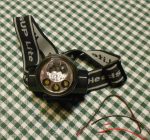 I tried adding a third bulb, but there was just not enough space around the reflector and lens assembly to accommodate three bulbs and their associated resistors. I next tried removing the resistors from three bulbs to save room, and soldering those three bulbs in series rather than in parallel. I believed the bulbs to be rated at 2 to 2.2 volts each, but felt it was better to slightly under drive them than to overdrive them by connecting just two. Connecting the three bulbs required some very fine soldering under a magnifying glass. My fine electrical work is somewhat inelegant at best, but is improving as I continue to attempt these kinds of projects. The resulting assembly did not light. I am not sure if my ten thumbs were just too big, or if the heat of the soldering iron damaged the LEDs while I was connecting them in series.
I tried adding a third bulb, but there was just not enough space around the reflector and lens assembly to accommodate three bulbs and their associated resistors. I next tried removing the resistors from three bulbs to save room, and soldering those three bulbs in series rather than in parallel. I believed the bulbs to be rated at 2 to 2.2 volts each, but felt it was better to slightly under drive them than to overdrive them by connecting just two. Connecting the three bulbs required some very fine soldering under a magnifying glass. My fine electrical work is somewhat inelegant at best, but is improving as I continue to attempt these kinds of projects. The resulting assembly did not light. I am not sure if my ten thumbs were just too big, or if the heat of the soldering iron damaged the LEDs while I was connecting them in series.
The Nite Ize Conversion
 I noticed that the Xenon bulb is very similar to the ones that are used in incandescent Mini-Maglites. I had several incandescent Mini-Maglites that I converted to LED using Nite Ize Conversion Kits. I decided to see if the conversion would work in the 2620. I inserted the pins on the conversion into the holes in the 2620, and it lighted nicely.
I noticed that the Xenon bulb is very similar to the ones that are used in incandescent Mini-Maglites. I had several incandescent Mini-Maglites that I converted to LED using Nite Ize Conversion Kits. I decided to see if the conversion would work in the 2620. I inserted the pins on the conversion into the holes in the 2620, and it lighted nicely.
 If I wanted this to be a permanent change, I could have trimmed the back of the reflector on the 2620 to fit. But since the Nite Ize conversion costs almost as much as a new headlamp, I was more interested in a proof of concept rather than a permanent conversion. Instead, I cut a circle of cardboard from the back of a legal pad, punched holes for the LEDs with a hole punch, and inserted in place of the reflector. In testing, the conversion provided a very nice flood.
If I wanted this to be a permanent change, I could have trimmed the back of the reflector on the 2620 to fit. But since the Nite Ize conversion costs almost as much as a new headlamp, I was more interested in a proof of concept rather than a permanent conversion. Instead, I cut a circle of cardboard from the back of a legal pad, punched holes for the LEDs with a hole punch, and inserted in place of the reflector. In testing, the conversion provided a very nice flood.
The Nite Ize Conversion was originally offered in red, but is now only available in white. That is a pity, because the red option would work extremely well with the 2620.
After testing other options, I found the two red LED bulb assembly difficult to reinsert securely. I was able to make it function for a while, but it eventually worked itself loose. Since I could not trust it to function reliably, I removed it and replaced it with a more reliable single LED assembly.
Although the single LED assembly is unsatisfactory in many ways, it does provide me with enough light to read a map while not destroying my night vision, and it drains the battery much more slowly than the Xenon bulb. I plan to continue to use it until I find a better alternative.
White LED Endurance Testing
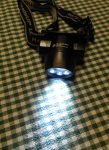 The claims of 80 hours of continuous use for the white LEDs seemed wildly optimistic. I suspected a typo, or that the manual was written with the help of a speech-to-text program that mis-transcribed “18 hours” as “80 hours”. So I decided to do some endurance testing. I inserted three Eneloop 800 mAh batteries with the original factory charge into the unit and began a white LED endurance test at 9:55 pm on day one. At 6:30 am on day two, the LEDs were still producing a useful amount of light, although not as bright as the night before. At 4:30 pm when I got home from work, they were still glowing gamely, albeit somewhat feebly. By the time I took the dog for a walk at 7:15 pm, the light was better than nothing, but not by much.
The claims of 80 hours of continuous use for the white LEDs seemed wildly optimistic. I suspected a typo, or that the manual was written with the help of a speech-to-text program that mis-transcribed “18 hours” as “80 hours”. So I decided to do some endurance testing. I inserted three Eneloop 800 mAh batteries with the original factory charge into the unit and began a white LED endurance test at 9:55 pm on day one. At 6:30 am on day two, the LEDs were still producing a useful amount of light, although not as bright as the night before. At 4:30 pm when I got home from work, they were still glowing gamely, albeit somewhat feebly. By the time I took the dog for a walk at 7:15 pm, the light was better than nothing, but not by much.
At 6:30 am on day three and then at 4:30 pm that afternoon, the light was still glimmering faintly. I terminated the test at 4:45 pm after almost 43 hours of continuous use, because although the headlamp was still producing some light, it had become so dim that it was of no practical value. The words of the manual now seemed more plausible: “ The LEDs will provide upwards of 80 hours of light. However, the illumination will noticeably reduce after a period of a few hours.” Depending on how bright you like your light and the type of battery you are using, I estimate that the headlamp will provide approximately 12 hours of useful illumination. But it won’t just suddenly quit on you. Like an old soldier, it will never die. Instead, it will very gradually fade away, giving you plenty of time to replace the batteries without ever quite leaving you completely in the dark.
Conclusion
The Pelican 2620 HeadUP Lite is a sturdy, reliable, long-lasting, water-resistant, American-made headlamp. If you find one at a second-hand store for 50 cents, snatch it up. But if you are looking for a new headlamp, I suggest that you try a different model. Look for something that doesn’t waste battery capacity on a Xenon bulb.

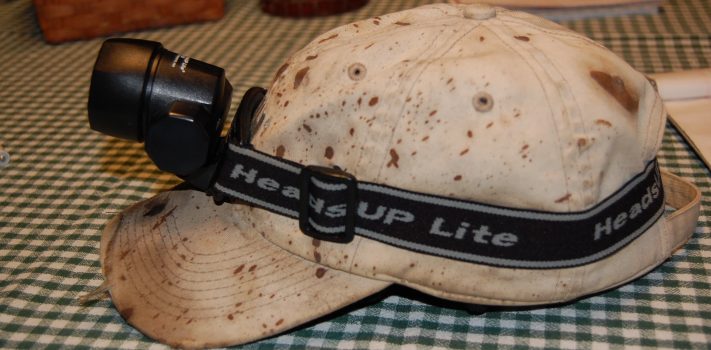









You call yourself The Novice, but this type of tinkering is at least the Journeyman level!
I like that you are not afraid to modify equipment to work for you. Your willingness to share your experience will motivate others to do the same.
I have been criticized for painting a rifle that was rusted and had bad a finish. Now I have a rifle that is camo and works for me and the way I use it.
As an old Submarine Electrician, I think you were right, that the heat from soldering cause the failure. That type of soldering requires special techniques, such as heat sinks.
Great article!
Elkmanjack, thank you for the encouraging word. And well done painting the rifle so that it works well for you. Will have to remember heat sinks the next time I am soldering so close to an LED.
Hmmm…… You may be finished tinkering with the 2620, but while reading about your experiments, I had a thought. Why not use the Night Ize white light kit in the formerly Xenon space and put 3 red LEDs in the former white LED space? This may solve the problem of the red LEDs not being bright enough and the spotlight LEDs being too bright for close work.
Great suggestion, Ma G. Will have to take another look at that unit.
Great article. One of these days I’m going to have to learn how to solder 😉
As for painting a rifle…I bought a rusty 22 bolt rifle at a pawn shop for $25 once and after cleaning, painted the metal gray and the stock black. Mechanically the rifle was in perfect condition and shot very well. At least in my mind the rifle was quite nice looking. I still have it and am quite pleased with my “find”.